Technology overview - safety light curtains
The primary goal of machine safety is to minimise the risk of possible injuries or damage to equipment and surroundings.This can be achieved through:
- Avoiding the risk during the design phase of the equipment
- Constructing physical barriers
- Using signage and operator training
- Using functional safety devices such as safety proximity sensors, light curtains, and light grids
Functional safety standards
In manufacturing, there is no such thing as zero risk.Risk can be evaluated and reduced to a tolerable level.“Functional safety” involves determining how much harm a situation can cause and control it by means of safety-related devices.
ifm cannot perform a risk assessment on applications.We promote light curtains and grids with the highest protection:
- Type 4
- SIL 3
- SIL cl 3
- PL e
There are several standards for machine safety.
- IEC 61508 is an international standard for functional safety for electric, electronic and programmable electronic devices.It defines the requirements for design, operation and maintenance of systems to meet a certain Safety Integrity Level (SIL).It is the reference standard, but other sector-specific standards are derived from IEC 61508.
- ISO 13849-1 defines the requirements for Performance Level (PL) for electric, electronic and programmable electronic devices specifically for machinery.
- IEC 62061 defines the requirements for Safety Integrity Level claim limit (SIL cl) for electric, electronic and programmable electronic devices as well as non-electrical machinery such as hydraulics and pneumatics.
- IEC 61511 defines the requirements for Safety Integrity Level (SIL) for process automation.
- IEC 61496-1 and -2 definethe requirements specifically for photoelectric devices like light curtains and grids (Type).
Terminology
Safety light curtains vs. safety light grids.
A safety light curtainissimilar to a photoelectric through-beam sensor in that ithasa transmitter and receiver.Multiple beams of infrared light surround the hazardous area and when interrupted, the light curtain sends a signal to the machine’s E-Stop circuit.Light curtains have several closely positioned beams of light (14…90 mm apart depending on the resolution) while light grids only have a few beams of light (2, 3 or 4) spaced much further apart (300…500 mm).Depending on the resolution, light curtains can be used for finger, hand or body protection, while light grids are used only for body protection.
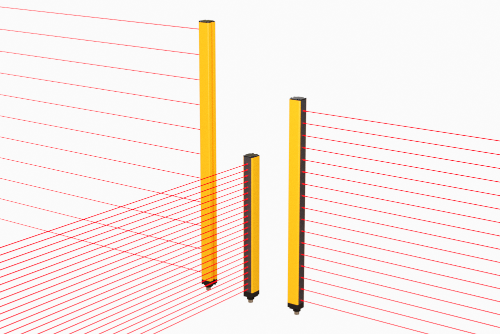
Type 2 vs. Type 4 light curtains and grids
When the functional safety device used is a photoelectric device, i.e. a light curtain or grid as opposed to an inductive proximity sensor, "Type" is used to define requirements in accordance with IEC 61496-1 and -2.
| Type 2 | Type 4 | |
|---|---|---|
| Control reliable | Checks for faults during start-up or re-start. | Continuously monitors itself for faults. |
| Effective aperture angle (EAA) |
5° EAA. Light beam may find unsafe alternate path when mounted near shiny surfaces known as an optical short circuit. | 2.5° EAA. Tighter effective aperture angle reduces risk of optical short circuit. |
| Redundant circuitry | Not required. | Includes duplicate critical components and circuits in order to provide a back-up system should the primary system fail. |
| Achievable safety level |
SIL cl 1 and PL c. | Meets the highest maximum achievable safety level requirements according to IEC61496: SIL cl 3 and PL e. |
| Cost | Lower cost. | Typically higher cost … but ifm Type 4 light curtain prices are comparable to Type 2 light curtain prices. |
Protected area height and width
Protected area height is not the overall length of the safety light curtain or grid.Rather, it is the area between the first and last light beam.Our safety light curtains offer protective heights from 160 to 1810 mm in increments of 150 mm and our safety light grids range from 500 to 900 mm.
The protected area width is the distance between the transmitter and receiver.It can also be thought of as range.All of our safety light curtains and grids can operate in high intensity mode, which increases the range.This is selectable via wiring.See below for details.
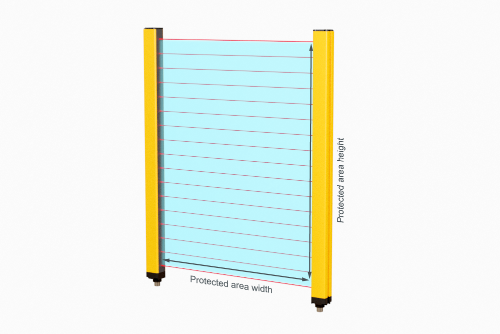
Access prevention vs. primary guarding
Access prevention refers to light curtains placed in close proximity to the machine to deny access to the dangerous areas.Primary guarding refers to light curtains or grids that are positioned around the perimeter of the machine to prevent access to the general area.
Resolution
Resolution is the sum of the diameter of a lens and the centre-to-centre distance between adjacent lenses.Objects larger than the resolution cannot pass through the protected area without causing a fault.The smaller the resolution, the smaller the object the light curtain can detect.
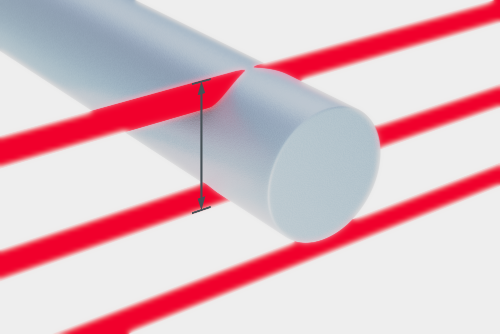
Muting applications
Muting temporarily overrides the safety function.Typical applications allow material being produced to pass through the light curtain or grid while denying operators access to the unsafe area.Muting is accomplished with ifm light curtains and grids by using them in conjunction with the G2001S safety relay.
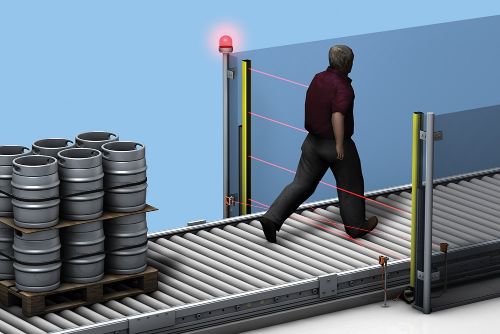
A palletiser erects a pallet of kegs and places it on a conveyor. Muting sensors are tripped and the pallet is allowed to leave the area (moving from right to left in the image.) If an operator attempts to enter the palletising area, the light curtain will detect his presence and cut power to the machine.
Blanking applications
Blanking allows 1, 2 or 3 consecutive beams to be broken without interrupting the safety circuit. These types of light curtains are generally used for material feed or exit applications.Floating blanking allows beams to be randomly broken within the protected area.The permanent blanking mode allows an object to be permanently in the protected area without disrupting the safety circuit.The mode of operation of ifm’s blanking light curtains can be selected via wiring.
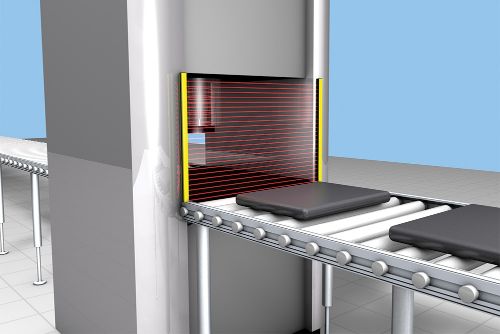
Steel plates are conveyed to a stamping press. The bottom of the beams can be triggered without interrupting the safety circuit. However, if an operator tries to reach into the press, the machine will stop immediately.
Cascading applications
Cascading allows multiple light curtains connected in series to create custom shapes.ifm does not offer cascading light curtains at this time.Each light curtain requires its own safety relay.
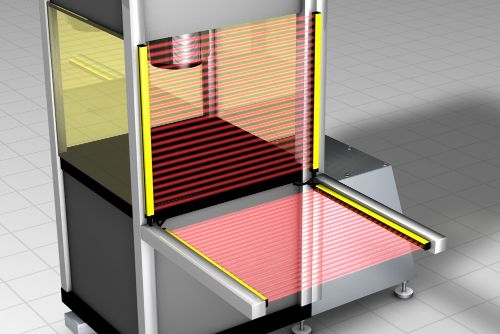
A light curtain can be mounted vertically against a machine, and a second one mounted horizontally in front of it.